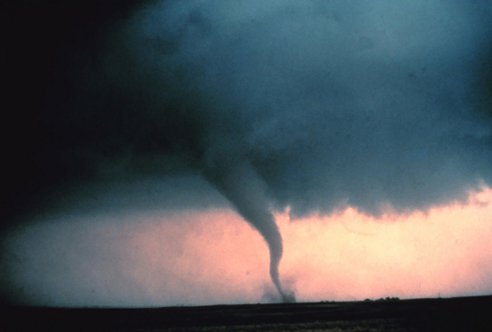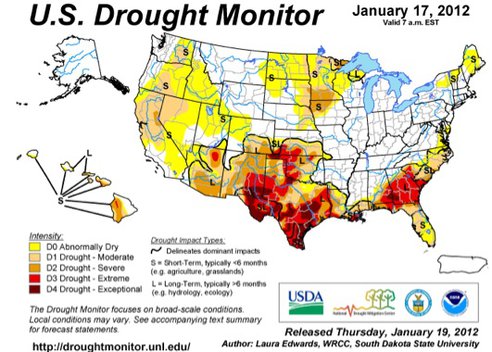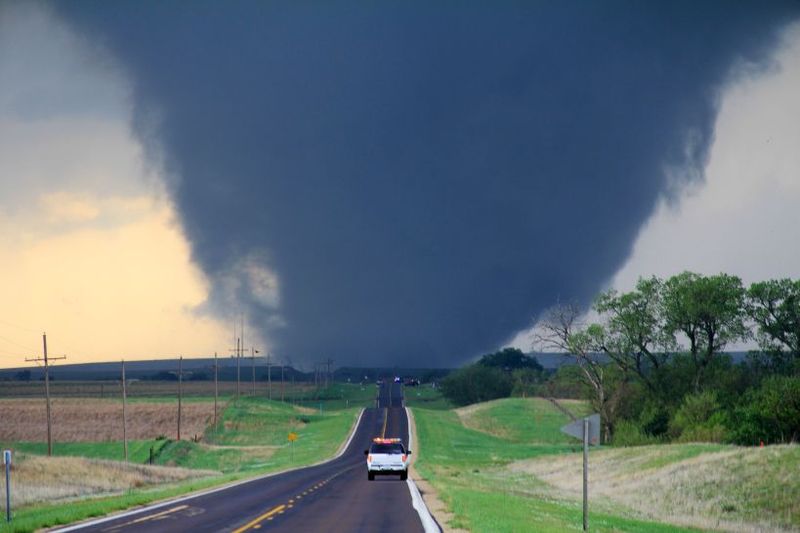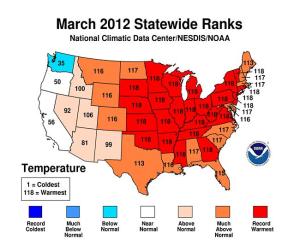

TEXAS TORNADIO APRILL 4, 2012
Dee Finney's blog
start date July 20, 2011
Tolday's date April 5, 2012
page 188
TOPIC: Extreme Weather USA: 2012 Kicks Off With Record Heat, Tornadoes & Drought
There have been 476 tornadoes in the U.S. since January 1
Foremost in the news isi the suddent Texas tornados of yesterday. That was a scary one, with a tornado in Dallas actually picked up entire trailer trucks and tosed them on top of houses. Fortunately, there were no reports of deaths.
Yesterday, a dozen tornadoes ripped through Dallas, spurring panic in a highly populated, 6 million-strong metropolitan area. The footage captured by news helicopters was dramatic—semi trucks and trees were hurled into the air like newspapers tossed from a malevolent paperboy.
http://www.youtube.com/watch?v=stX1Avy4qHg&feature=sh_e_top&list=SL
But the fleet of Texan tornadoes only marks the latest in a year that has already been packed with extreme weather—we've had record-hot winter months, unusually early tornadoes in the midwest, and states wracked with drought. Here's a closer look.
There was nothing tremendously out of the ordinary about the tornadoes that hit Dallas, but climatologists were concerned about the spate of twisters that swept through Kentucky, Indiana, and three other states in early March. Those tornadoes killed 39 people and exacted untold property damage to homes and buildings across the region.
And tornado season doesn't usually begin until April, leading climate scientists to link the warmer weather to earlier (and potentially longer) seasons. Here's Joe Romm:
The unexpectedly fierce and fast tornado outbreak so early in the season has folks asking again about a possible link to climate change. Climatologist Dr. Kevin Trenberth emailed me that, because of climate change, “there is every expectation that the [tornado] season will move up in time. The warm winter in the US is perhaps an indicator of the nature of the changes to be expected.”
Trenberth also elaborates on the link between tornadoes and climate change in a recently published paper, which notes that "Global warming does not contribute directly to tornadoes themselves, but it does contribute to the vigor of the thunderstorms that host them through the increased warmth and moisture content (moist static energy) of the low level air flow." Meaning: there's no evidence tornadoes themselves are more powerful, but the storms from which they come will be. Which is one reason climatologists speculate that the 2011 tornado season broke records in terms of casualties—539 were killed by 1070+ tornadoes.

USDA
and NOAA/Public Domain
The 2011-12 winter has become the "winter that wasn't" in common parlance, and for good reason. Climatologists have confirmed that it was the fourth warmest winter season on record. Furthermore, for much of the nation, March was the hottest ever—25 cities and regions broke heat records last month.
Reuters reported that "Last month was the warmest March on record across half of the United States with summer-like temperatures." And "Accuweather.com said cities in more than 25 states, as well Washington, D.C., broke records for average daily temperatures last month, including Chicago, Oklahoma City, Des Moines, Milwaukee, Indianapolis and Detroit."
Statisticians and meteorologists point out that we're breaking many more heat records than cold ones—which is useful evidence that global warming is continuing an ascendent trajectory.
Drought was a major story in 2011, especially in Texas, where the majority of the state was parched for most of the year. Well, that drought stretched on into 2012, too. And though the state was met with a brief reprieve with some scattered rainfall in late February, drought conditions stretched on through March. 70% of the state was listed as experiencing "severe drought", and 14% suffered from "exceptional" drought.
But it's not just Texas. Colorado too has entered an unusual drought—according to the Denver Post, a startling "98 percent of the state is experiencing varying levels of drought."
Wendy Ryan, a research associate at the Colorado Climate Center, told the Post that "In Fort Collins, we had the hottest and driest March on record ... This is the first time we've ever had only a trace of precipitation for March. No years have had zero."
And now for the inevitable disclaimer: No single specific weather event can be said to be caused by global climate change. But scientists are anything but hesitant to explain that the kinds of phenomena described above are symptomatic of global warming—these are the kinds of things we'll expect to see more of in a warming world. And the combined weight of each; of the hottest-ever record temperatures that continue to be broken, of the increasingly ornery storm systems, of the unprecedented dry seasons, all help drive home on a visceral level what the scientists have been telling us for decades now.
Human activity is causing the world to warm. Warmer temperatures means the air holds more moisture, so: Wet areas will get wetter. More rain, more storms. Where there's little moisture to be found in the first place, the hot, dry regions will become hotter—and drier. The extremes are exacerbated; that's the calling card of global climate change.
For a useful final word, here's Dr. Trenberth: "The answer to the oft-asked question of whether an event is caused by climate change is that it is the wrong question. All weather events are affected by climate change because the environment in which they occur is warmer and moister than it used to be…"
URL: http://www.spc.noaa.gov/climo/online/monthly/2012_annual_summary.html#
| Pn these graphs, I'm
seeing 383 "confirmed" tornado reports. For instance, the most
tornadoes in one day so far has been on this date shown in the above
graph (March 2nd) which shows 160 tornados, but only 132 "confirmed"
reports in the final tally. Apparently what happens is that several reports will come in for one tornado that has a long path. As I remember, some of the tornados for that date had paths of up to 20 miles long. What's amazing to me is that there weren't any fatalities from that Texas outbreak. That's miraculous! This was just 6 days before the 19th anniversary of the <BR>Mothers Day tornado that hit the Dallas suburbs of Sachse <BR>and Wylie on May 9, 1993. The largest tornado outbreak ever recorded; April 25-28, 2011 I remember well. 346 fatalities, and 11 billion dollars worth of damage total!!! The whole article is just mindboggling. <BR><BR><BR>An extremely large and violent tornado outbreak, the largest tornado outbreak ever recorded, and popularly known as the 2011 Super Outbreak, occurred from April 25 to 28, 2011. The outbreak affected the Southern, Midwestern, and Northeastern United States, leaving catastrophic destruction in its wake, especially across the state of Alabama.[ It produced destructive tornadoes in Alabama, Arkansas, Georgia, Mississippi, Tennessee, and Virginia, and affected many other areas throughout the Southern and Eastern United States. In total, 358 tornadoes were confirmed by the National Weather Service in 21 states from Texas to New York and even isolated tornadoes in Canada. Widespread and destructive tornadoes occurred on each day of the outbreak, with April 27 being among the most prolific and destructive tornado days in United States history with a record 208 tornadoes touching down that day. Four of the tornadoes were destructive enough to be rated EF5 on the Enhanced Fujita Scale, which is the highest ranking possible; typically these tornadoes are only recorded about once each year or less. In total, 346 people were killed as a result of the outbreak. That death toll includes 322 tornado-related deaths across six states. In addition, 24 fatalities were not caused by tornadoes, but were confirmed to be as a result of other thunderstorm-related impacts such as straight-line winds, hail, flash flooding or lightning.[8][9] 239 deaths in Alabama alone were confirmed by the SPC and the state's Emergency Management Agency.[2][8]<BR><BR>April 27 was the deadliest tornado day in the United States since the 1925 "Tri-State" outbreak,[10] which produced the infamous Tri-State Tornado.[11][12] Although it has been classified by some news outlets as the second-deadliest tornado outbreak in United States history,[13][14] the 1936 Tupelo–Gainesville tornado outbreak [15] actually holds that distinction with at least 436 reported deaths split almost evenly over two days. Officially the outbreak is listed by NOAA as the fourth deadliest in United States history [16] and the 24-hour-period from 8:00 a.m. April 27 to 8:00 a.m. April 28 as the fifth deadliest tornado day in United States history.[7] Nearly 500 preliminary local storm reports were received for tornadoes over four days, including 292 in 16 states on April 27 alone.[17] It was also the costliest tornado outbreak and one of the costliest natural disasters in United States history (even after adjustments for inflation), with total damages of nearly $11 billion (2011 |
Shocking Must See Dallas Tornado April 3rd 2012, 4/3/2012 ... |
|
|
www.youtube.com/watch?v=uSs45dJGOlEApr
3, 2012 - 4 min -
Uploaded by mywonderjam
Dallas Tornado : (Reuters) - At least two tornadoes tore through the Dallas-Fort Worth metropolitan area in ... |
|
Dallas Texas Tornadoes April 3, 2012 - List of Videos of News ... |
|
|
www.youtube.com/watch?v=TK6jVmYE48sApr
3, 2012 - 1 min -
Uploaded by abjectartist
Sheltering After April 3 Texas Tornadoes Posted April 3, 2012 http://www.youtube .com/watch?v=vgIVY0aUq8k ... |
|
|
|
|
| Date of tornado outbreak: | April 13–16, 2012 |
| Duration1: | Four days |
| Maximum rated tornado2: | EF4 tornado |
| Tornadoes caused: | 71 confirmed, 183 reported |
| Damages: | At least $283 million (in Wichita, unknown elsewhere)[1] |
| Fatalities: | 6[2] |
| Areas affected: | Central United States, Great Lakes region |
|
1Time from first tornado to last tornado |
|
 resulted in 6
tornado-related fatalities, all of which occurred in a mobile home park
in
Woodward, Oklahoma, where an EF3 tornado on the
Enhanced Fujita Scale caused significant damage and leveled at least
10 homes.
resulted in 6
tornado-related fatalities, all of which occurred in a mobile home park
in
Woodward, Oklahoma, where an EF3 tornado on the
Enhanced Fujita Scale caused significant damage and leveled at least
10 homes.

The average temperature of 51.1°F was 8.6 degrees above the 20th century average for March and 0.5°F warmer than the previous warmest March in 1910. Of the more than 1,400 months (117+ years) that have passed since the U.S. climate record began, only one month, January 2006, has seen a larger departure from its average temperature than March 2012.
Note: The March 2012 Monthly Climate Report for the United States has several pages of supplemental information and data (www.ncdc.noaa.gov/special-reports/march-2012-heat-wave/) regarding the unprecedented early 2012 temperatures.
U.S. climate highlights -- March
Year-to-date (January-March)
Cold season (October-March) and 12-month period (April 2011-May 2012)